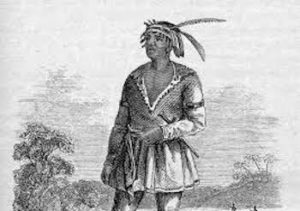
John Horse
*The birth of John Horse is celebrated on this date, c. 1812. He was an African and Native American soldier who fought alongside the Seminoles in the Second Seminole War in Florida.
John Horse was from the region called Micanopy in north central Florida. His father was the Seminole trader Charley Cavallo, and his mother was an African slave acquired by Cavallo. He had a sister, Juana. The Horse was raised when the American federal government instigated the Seminole Wars.
He rose to prominence in the third year of what was to become a seven-year war of the first generation of Black Seminole leaders—eventually decimated under Seminole war chief Osceola, falling into the hands of the white-American military commander, General Thomas Sydney Jesup. Horse had been fighting alongside Osceola and acting as his interpreter. Seized while under a flag of truce negotiating with Jesup's emissary, militia general Joseph Hernandez, Horse was imprisoned with Osceola and others at Fort Marion (Castillo de San Marcos), the old Spanish fort in St. Augustine, Florida.
Horse was initially distinguished for joining Mikasuki's brave Wildcat (Coacoochee) to escape from the fort. Wildcat and Horse allied and went on to lead the remnants of the shattered Seminole bands, including members of the Mikasuki, Tallahassee, Apalachee, and Yamasee bands (in what was by then a highly mixed grouping of Indians and Africans) to safety in the south-central part of Florida, ahead of white forces.
In the Battle of Lake Okeechobee on Christmas Day in 1837, Halpatta Tustanagi, an ally of the captured Osceola, and Seminole medicine man Abiaka led Wildcat and Horse in holding off the assault of Zachary Taylor. They successfully escaped by crossing Lake Okeechobee to take refuge in the Everglades. They fought Jesup himself on the Loxahatchee River the following January 1838; the Seminoles were forced to flee again. Offered a promise of peace and a new life west of the Mississippi with his family, Horse finally agreed to surrender. However, Wildcat refused then and fought until around 1840, when Horse was brought back to Florida from exile in Indian Territory.
Horse brought the offer of peace to Wildcat, contingent on his surrender and agreement to exile in Indian Territory, and Wildcat, by now the leading war chief of the remaining Seminole, finally accepted removal to the Territory (in present-day Oklahoma), which had been set aside for the eastern Natives in the early 1830s by the Indian Removal Act. Other bands still held out, though. The war continued until August 14, 1842, when Colonel William J. Worth finally declared "victory" and left the remaining fighters to their own devices deep in the Florida Everglades.
When the Africans living among the Seminole continued to face threats of re-enslavement in their new home, Horse again joined forces with Wildcat to lead a group of disaffected Seminole and former slaves across the Rio Grande to northern Mexico. There, they were granted land by the Mexican government in 1850, and the Black Seminoles could finally be assured of their freedom, Mexico having abolished legal slavery in the 1820s.
Horse served as a captain in the Mexican army during this period and, after 1870, briefly with the US Army again as a Seminole Scout. He disappeared several years later when, now an older man, he traveled to Mexico City to plead for reaffirmation of the land grant to his people, which local Mexican landowners sought to overturn. It is generally thought that John Horse died during this final errand to Mexico City in 1882.